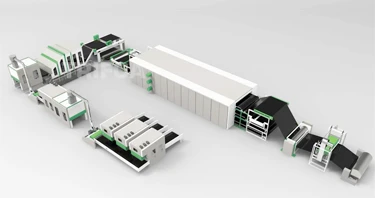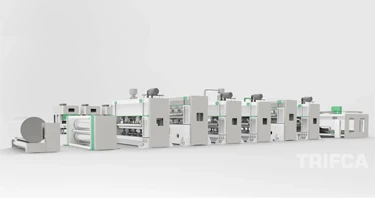PRODUCTION LINE
Trifca can produce a wide range of different popular nonwoven lines. Needle Punch Nonwovens / Geotextile / Nonwoven Substrate / Automotive Interiors / Waterproof Materials / Non-Adhesive Cotton Yarns / Filter Felts / Filtering Products / Synthetic Leather Nonwovens. /Agriculture/ Construction and Insulation/ Packaging and Packaging/ Artificial Leather Substrate/ Interlining Tulle/ Home Textiles/ Carpets/ Furniture Bedding/ Wet Dry Wipes/ Personal Care/ Upholstery Materials/Polyester Wipes/ Geo-Nonwovens/ Tablecloths

Thermal Bonded

Hava Serimli Termal Yapıştırma Üretim Hattı
Thermal Bonded
Thermal bonding is a technique of bonding a web of fibres in which a pressurised or non-pressurised heat or ultrasonic process is used to activate a heat-sensitive material. The material can be in the form of homophilous fibres, bicomponent fibres and fusible powders as part of the web. The bonding can be applied all over (e.g. through or area bonding) or limited to predetermined, discrete areas (e.g. spot bonding).
There are different types of thermal bonding systems that can be used:
Calender bonding thermally bonds a web of loose fibres by passing it through the nip of a pair of calender rollers, one or both of which are heated.
Air-bonding (or air-bonding) is a bonding system that uses high-temperature air to fuse the web fibres. There are two basic systems: blowing hot air through the web in a conveyor oven or passing heated air through the web on a rotating drum.
Ultrasonic bonding is the use of high frequency sound to generate localised heat through vibration and cause thermoplastic fibres to bond together.
Thermally bonded nonwovens can be thin – which goes to the core of feminine care products – or high loft materials several inches thick.




